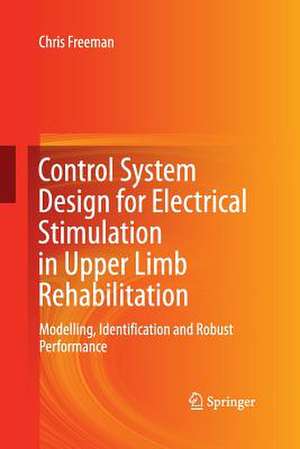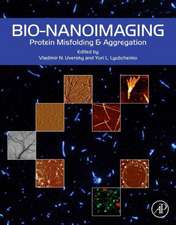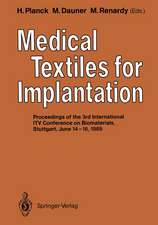Control System Design for Electrical Stimulation in Upper Limb Rehabilitation: Modelling, Identification and Robust Performance
Autor Chris Freemanen Limba Engleză Paperback – 23 aug 2016
The book first demonstrates procedures for modelling and identifying biomechanical models of the response of ES, covering a wide variety of aspects including mechanical support structures, kinematics, electrode placement, tasks, and sensor locations. It then goes on to demonstrate how complex functional activities of daily living can be captured in the form of optimisation problems, and extends ES control design to address this case. It then lays out a design methodology, stability conditions, and robust performance criteria that enable control schemes to be developed systematically and transparently, ensuring that they can operate effectively in the presence of realistic modelling uncertainty, physiological variation and measurement noise.
| Toate formatele și edițiile | Preț | Express |
|---|---|---|
| Paperback (1) | 710.06 lei 6-8 săpt. | |
| Springer International Publishing – 23 aug 2016 | 710.06 lei 6-8 săpt. | |
| Hardback (1) | 717.00 lei 6-8 săpt. | |
| Springer International Publishing – 4 noi 2015 | 717.00 lei 6-8 săpt. |
Preț: 710.06 lei
Preț vechi: 747.43 lei
-5% Nou
Puncte Express: 1065
Preț estimativ în valută:
135.90€ • 141.35$ • 113.89£
135.90€ • 141.35$ • 113.89£
Carte tipărită la comandă
Livrare economică 14-28 martie
Preluare comenzi: 021 569.72.76
Specificații
ISBN-13: 9783319370927
ISBN-10: 3319370928
Pagini: 176
Ilustrații: XIII, 176 p.
Dimensiuni: 155 x 235 mm
Greutate: 0.28 kg
Ediția:Softcover reprint of the original 1st ed. 2016
Editura: Springer International Publishing
Colecția Springer
Locul publicării:Cham, Switzerland
ISBN-10: 3319370928
Pagini: 176
Ilustrații: XIII, 176 p.
Dimensiuni: 155 x 235 mm
Greutate: 0.28 kg
Ediția:Softcover reprint of the original 1st ed. 2016
Editura: Springer International Publishing
Colecția Springer
Locul publicării:Cham, Switzerland
Cuprins
Introduction.-Modelling and Identification.- Combined FES & Robotic Upper Limb Dynamics.- Model Identification.- Feedback Control Design.- Iterative Learning Control Design.- Clinical Application: Multiple Sclerosis.- Constrained ILC for Human Motor Control.- Clinical Application: Goal-orientated Stroke Rehabilitation.- Electrode Array-based Stimulation.- Clinical Application: Fully Functional Stroke Rehabilitation.- Conclusions and Future Research Directions.
Notă biografică
Over the last ten years Dr. Freeman has developed new healthcare technologies combining robotics and electrical stimulation to enable people with upper limb impairments to perform functional tasks. Over this time he has worked closely with clinicians (including former IFESS president Prof Jane Burridge), patients and carers. These include five clinical trials using technology he has developed, as well as numerous smaller studies and user-led design sessions. His focus has been to understand and define clinical problems within an engineering perspective and translate this into usable solutions.
Dr. Freeman's background in adaptive and learning control of robotic structures has enabled him to rigorously tackle the challenge of designing systems that provide high performance in the face of significant model uncertainty/variability, restrictive clinical conditions, and complex dynamics/tasks. These problems have led to a productive interaction in his research between theory and practice (the latter generally providing new problems that need an algorithmic or theoretical solution). This is reflected in my publications which include 70 peer-reviewed journal papers and 130 peer-reviewed conference papers covering the spectrum from control application,
control theory, rehabilitation engineering, biomechanics, clinical studies and user perspectives. The research he has led in control of ES has elicited two best conference paper awards (ICORR '09, UKACC '12), and two best journal paper awards (most recently `2013 IEEE Control Systems Society Outstanding Paper Award' based on `impact on the field of systems and control'). For example, his work using iterative learning control and adaptive control for stroke rehabilitation has met with an enthusiastic response from the research community, with invited workshops at IEEE BioRob Conference 2012, 18th IFESS Conference 2013, World Congress in NeuroRehabilitation 2014, as well as a plenary at IEEE International Workshop on nD Systems 2013. Citations for my research using both ES and advanced control in the last 5 years exceed 500.In a wider content, the last 10 years has seen a steady increase in research papers, funding calls, and postgraduate courses related to assistive technologies. An example of the latter is an EU-funded MSc in ‘Advanced Rehabilitation Technologies’ involving 10 EU partners that he is currently helping to develop.
His work in control design for systems combining ES and mechanical support is motivated by the lack of model-based controllers that reach clinical or commercial application and it has elicits an international response, from TU Berlin, ETH Zurich, U. Washington and U. California who have since applied iterative learning control-based FES to the lower limb.
Textul de pe ultima copertă
This book presents a comprehensive framework for model-based electrical stimulation (ES) controller design, covering the whole process needed to develop a system for helping people with physical impairments perform functional upper limb tasks such as eating, grasping and manipulating objects.
The book first demonstrates procedures for modelling and identifying biomechanical models of the response of ES, covering a wide variety of aspects including mechanical support structures, kinematics, electrode placement, tasks, and sensor locations. It then goes on to demonstrate how complex functional activities of daily living can be captured in the form of optimisation problems, and extends ES control design to address this case. It then lays out a design methodology, stability conditions, and robust performance criteria that enable control schemes to be developed systematically and transparently, ensuring that they can operate effectively in the presence of realistic modelling uncertainty, physiological variation and measurement noise.
The book first demonstrates procedures for modelling and identifying biomechanical models of the response of ES, covering a wide variety of aspects including mechanical support structures, kinematics, electrode placement, tasks, and sensor locations. It then goes on to demonstrate how complex functional activities of daily living can be captured in the form of optimisation problems, and extends ES control design to address this case. It then lays out a design methodology, stability conditions, and robust performance criteria that enable control schemes to be developed systematically and transparently, ensuring that they can operate effectively in the presence of realistic modelling uncertainty, physiological variation and measurement noise.
Caracteristici
Brings together principles of modelling, identification, control design and robust performance analysis in one convenient volume Features illustrative case studies and results from three clinical trials Demonstrates how theoretical tools can be applied to yield robust performance conditions bounding unmodelled dynamics and user fatigue Includes supplementary material: sn.pub/extras





















